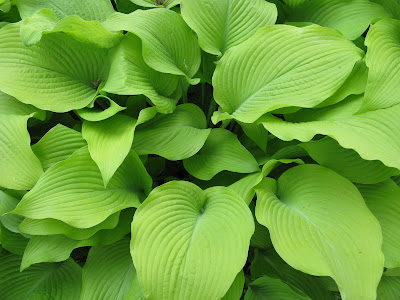Despite the wonderful attributes of the now very popular Geranium 'Rozanne' and its very similar cousin 'Jolly Bee', I still like many others, including this one, G. × magnificum (a sterile hybrid from G. ibericum × platypetalum). I like the two or even three-tone flowers and their relative abundance. This plant is a good example of the principle of "hybrid vigour" for this child easily out-performs both of its parents. In any case, it's a great plant for a partially shaded location.

Also at its peak was Campanula 'Samantha', a likely C. carpatica hybrid that has very pleasant upward facing bellflowers, and a somewhat longer bloom-time due to its sterility.

Here's a great, and a not-so-great plant in a colourful combination. The gold-leaved Sedum reflexum 'Angelina' is a superb plant for its drought-resistant and vigorous nature, and obviously, its colourful foliage. The dark one in the middle however, is S. 'Black Jack', a sport of the deservedly popular 'Matrona', that was once promoted as possibly the best of the dark-leaved Sedums. Black Jack was a major disappointment for most, being rather prone to mildew and genetic instability. The two plants do here make a pleasant combination, but I'd hate to see how 'Black Jack' looks in a few weeks.

This is Dianthus gratianopolitanus 'Tiny Rubies', a cute dwarf, and floriferous Pink that is ideal for the rock garden or little alpine planters. It's been around for years, and oftentimes puts most of the new hybrids to shame due to its hardiness and durability.

Here's the old Campanula 'Birch Hybrid' (C. portenschlagiana × C. poscharskyana) in all its glory -- just covered with beautiful purple-blue, star-shaped bellflowers.

This is the rare but beautiful Sedum sieboldii 'Mediovarigatum' -- relatively rare for a Sedum due to its instability, which makes it difficult to propagate; beautiful for its multi-coloured leaves and stems.

This is one of my favourite Hostas, especially for a variety that is non-variegated, or has a solid-coloured leaf. In any case, H. 'Sun Power' is a great plant for its vigour and size, and its beautiful yellow-green leaves. As its name indicates, it is also relatively sun-tolereant.

The Perennial Sages are certainly in the Top 10 Perennials by Genus, likely on the coattails of popular varieties like 'May Night' (Mainacht) and 'East Friesland' (Ostfriesland). Below is the more recent variety 'Caradonna', one that I like for the contrast between the purple flowers and the dark stems. It is from Zillmer Nursery in Germany, and was discovered as a seedling of S. 'Wesuwe'.

Here's a pleasant combination in the butterfly garden, of Nepeta 'Walker's Low', a Weigelia, and Geranium × cantabrigiense 'Biokovo'.

A Dogwood of some sort, Cornus kousa would be my guess -- what a beautiful plant.

This is a very cool small tree called Old Man's Beard (Chionanthus virginicus), native to most of the eastern U.S. It is also known as White Fringetree.

We've enjoyed a lengthy Spring-season here this year.
Here's to dirt under your nails.
MPD, the coolplantsguy






















